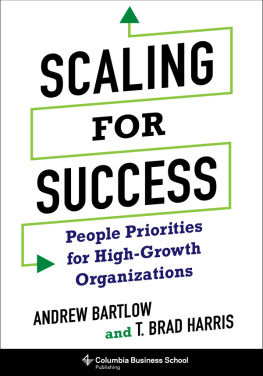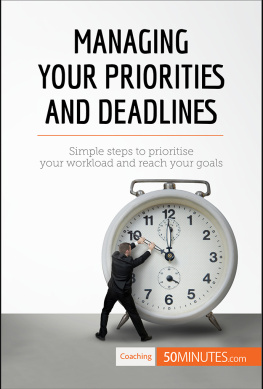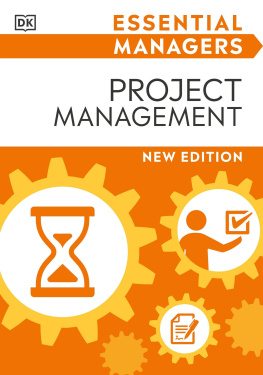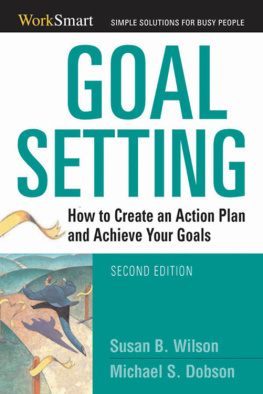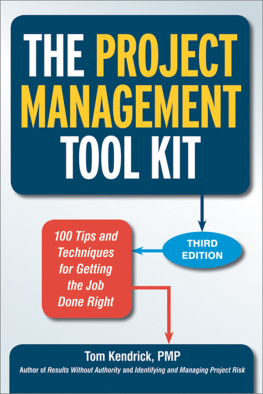How to Manage Your Priorities
Second Edition
How to Manage Your Priorities
Second Edition
Janis Fisher Chan

2007 American Management Association. All rights reserved. This material may not be reproduced, stored in a retrieval system, or transmitted in whole or in part, in any form or by any means, electronic, mechanical, photocopying, recording, or otherwise, without the prior written permission of the publisher.
ISBN-13: 978-0-7612-1464-9
ISBN-10: 0-7612-1464-X
Printed in the United States of America
10 9 8 7 6 5 4 3 2 1
Contents
About This Course
In todays competitive global environment, where people at all levels in organizations need to accomplish more in less time with fewer resources, the ability to manage priorities is a key factor in personal and professional success. How to Manage Your Priorities, Second Edition, teaches managers, team leaders, professionals, and others in the workplace to master this essential business skill.
In the second edition, revised and updated with a new chapter on technology-based tools, students will learn the critical benefits of managing their priorities and the common obstacles that interfere with success. They will practice goal-setting techniques and strategies for linking goals and priorities. They will learn to consider tasks and activities in terms of consequences and to separate what is urgent from what is important. Through scenarios, examples, and self-paced exercises, students will acquire strategies for focusing on outcomes and clarifying expectations, evaluating available resources, eliminating unnecessary tasks, and developing delegation skills. Students will learn techniques for planning and scheduling, the keys to working efficiently, and how technology-based tools can help manage their priorities and achieve personal and professional goals.
After completing this course, students will have acquired the knowledge and skills to realize the many benefits of managing their priorities: more productive working relationships; better outcomes, with fewer mistakes; and increased productivity through better use of their time. They will also realize the benefits of improved work/life balance, enhanced personal and professional relationships, and reduced stress.
Janis Fisher Chan, a writer, editor, trainer, and instructional designer, specializes in helping people communicate clearly and work productively. As a partner in the training and publishing company Write It Well, she has developed and conducted customized workshops on business writing, interpersonal communication, performance management, delegating, managing priorities, meeting planning, and making presentations. She has designed numerous self-study and classroom training programs; developed facilitators guides, participant workbooks, and other learning materials; and written and edited books, training materials, proposals, reports, marketing materials, manuals, and other documents. In addition to the first edition of How to Manage Your Priorities, her self-study courses for the American Management Association include Delegating for Business Success, Presentation Success, and Communication Skills for Managers, Fifth Edition. She is also the co-author of five business writing books, including E-Mail: A Write It Well Guide How to Write and Manage E-Mail in the Workplace, available through www.writeitwell.com, and of The Jossey-Bass Academic Administrators Guide to Meetings. Her e-mail address is janisdee@comcast.net.
How to Take This Course
This course consists of text material for you to read and three types of activities (the pre- and post-test, in-text exercises, and end-of-chapter review questions) for you to complete. These activities are designed to reinforce the concepts introduced in the text portion of the course and to enable you to evaluate your progress.
PRE- AND POST-TESTS*
Both a pre-test and post-test are included in this course. Take the pre-test before you study any of the course material to determine your existing knowledge of the subject matter. Submit one of the scannable answer forms enclosed with this course for grading. On return of the graded pre-test, complete the course material. Take the post-test after you have completed all the course material. By comparing results of the pre-test and the post-test, you can measure how effective the course has been for you.
To have your pre-test and post-test graded, please mail your answer forms to:
Educational Services
American Management Association
P.O. Box 133
Florida, NY 10921
All tests are reviewed thoroughly by our instructors and will be returned to you promptly.
*If you are viewing the course digitally, the scannable forms enclosed in the hard copy of AMA Self-Study titles are not available digitally. If you would like to take the course for credit, you will need to either purchase a hard copy of the course from www.amaselfstudy.org or you can purchase an online version of the course from www.flexstudy.com.
THE TEXT
The most important component of this course is the text, where the concepts and methods are presented. Reading each chapter twice will increase the likelihood of your understanding the text fully.
We recommend that you work on this course in a systematic way. Reading the text and working through the exercises at a regular and steady pace will help ensure that you get the most out of this course and retain what you have learned.
In your first reading, concentrate on getting an overview of the chapter content. Read the learning objectives at the beginning of the chapter first. They will act as guidelines to the major topics of the chapter and identify the skills you should master as you study the text. As you read the chapter, pay attention to the headings and subheadings. Find the general theme of each section and see how that theme relates to others. Dont let yourself get bogged down with details during the first reading; simply concentrate on understanding and remembering the major themes.
In your second reading, look for the details that underlie the themes. Read the entire chapter carefully and methodically, underlining key points, working out the details of examples, and making marginal notes as you go. Complete the activities.
ACTIVITIES
Interspersed with the text of each chapter you will find a series of activities. These can take a variety of forms, including essays, short-answer quizzes, or charts and questionnaires. Completing the activities will enable you to try out new ideas, practice and improve new skills, and test your understanding of the course content.
THE REVIEW QUESTIONS
After reading a chapter and before going on to the next chapter, work through the Review Questions. Answering the questions and comparing your answers to those given will help you to grasp the major ideas of that chapter. If you perform these self-check exercises consistently, you will develop a framework in which to place material presented in later chapters.
GRADING POLICY
The American Management Association will continue to grade examinations and tests for one year after the courses out-of-print date.
If you have questions regarding the tests, the grading, or the course itself, call Educational Services at 1-800-225-3215 or send an e-mail to ed_svc@amanet.org.
Next page

